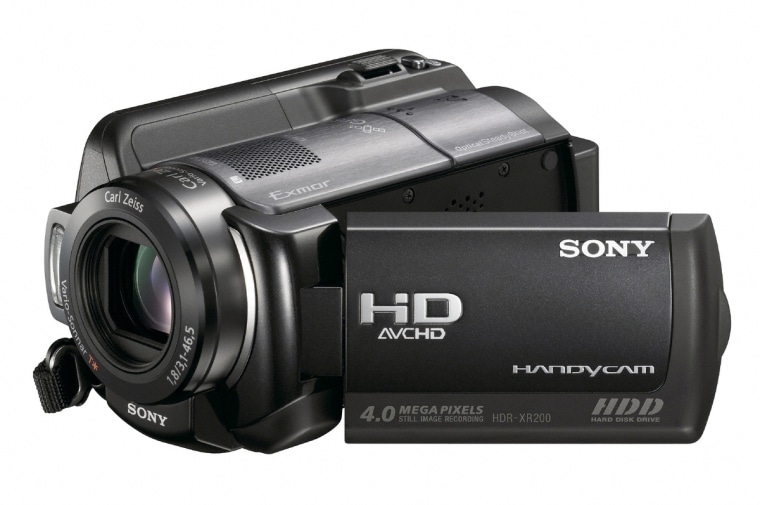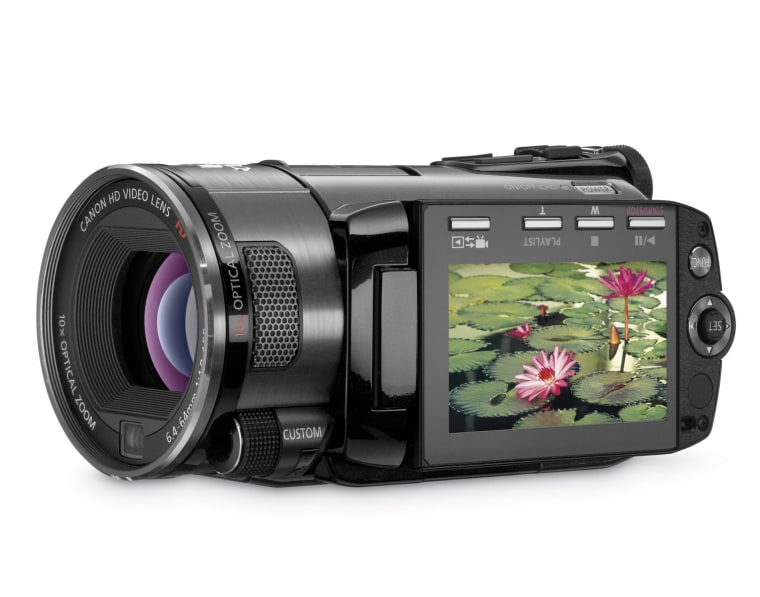Some of them are hybrids and some are GPS-enabled. They're not cars, they're digital camcorders and the recent generation of them have almost as many options as automobiles have.
Want to take 8-by-10 quality photos at a friend's wedding, as well as high-definition video? Canon's "hybrid" VIXIA HF S100 includes an 8-megapixel camera. Into "geo-tagging" your video so you know the exact location of where it was shot? Several of Sony's camcorders, including the HDR-XR200 V, have built-in GPS. Like a hint of color in your camcorder? Samsung's SMX-C14 and C10 camcorders, due out this summer, infuse a subtle dose of red, gray or teal into the black body of the video cam.
Many cameras and phones do double duty for taking short videos, and the pocket-sized Flip camera brought simple video and easy YouTube-uploadability to the masses, with prices starting at around $149. It also incorporated the use of flash memory — not a hard drive or mini-DV tape — to store video until it is offloaded to a computer or to the Web. More companies are incorporating flash memory, which has also led to smaller, sleeker consumer video cams, many weighing a pound or less.
"The days of the rocket launcher-sized camcorder are far gone," said Darryl Cole, product manager for Samsung camcorders.
Flash memory is "going to be the media of choice in the future" for camcorders, said Ross Rubin, director of industry analysis for The NPD Group, and more companies such as Sony, Canon and Samsung are moving to use flash memory in more of their devices instead of hard disk drives, mini-DVDs or mini-DV tapes.

Canon gives customers three choices for storage: flash memory, hard disk drives and mini-DV tapes, said Ben Thomas, supervisor of Canon USA's Consumer Imaging Group for video marketing.
"Currently, camcorders with hard drives are the most popular format because of their size, which means more recording time," he said. "For example, we've got camcorders with 32 gigabytes of built-in flash memory, which means you can record up to 12 hours of video. If you look at hard disk drive models, we have a 120-gigabyte model that can get up to 48 hours of recording time.
"But with flash memory technology, the numbers are getting higher, and we see it as the most dominant format by 2010," Thomas said.
Samsung, a leading manufacturer of flash memory, is using it in almost all of its camcorders.
"We don't make any hard drive camcorders," said Cole. "We kind of skipped right over that technology. We identified years ago that flash was the way to go, and so that's where we allocated our resources."
Flash drives, he said, are "more durable, much smaller, much better on battery life, and they're very quiet. A lot of camcorders with DVDs and hard drives make a lot of noise and emit a lot of heat. Flash memory avoids those issues."
Many companies that use flash memory also provide a slot on the camcorder for an SD or SD High Capacity (SDHC) card for additional video storage.
The first question for buyers of any camcorder is "asking yourself what kind of recording format do you want?" said Thomas. The second, he said, is whether to get a video cam that records in high definition versus standard definition.
With a growing number of households buying HDTVs, some of them will want to capture "milestone" kinds of events, like graduations or weddings, in high-definition video, Rubin said. (Although, if the bride or groom sweats profusely, seeing it in HD may not be so attractive, a downside to HD's lifelike quality.)
Standard-definition video has 480 lines of resolution, and high-definition video is up to 1,080 lines of resolution.
Camcorders that shoot high definition also are more expensive, generally $500 and up, but prices are starting to come down, said Rubin.
Manufacturers are also trying to distinguish their video cams with additional features and technical help.
Canon's high-definition, flash memory-based "hybrid" VIXIA HF S100 (retail price around $1,100) has an 8-megapixel camera, a significant step up from its last camcorder/camera combo, which had a 3-megapixel camera, Thomas said.
"This product will attract people who want both a camera and a camcorder with them, but just want to carry one piece of equipment with them, knowing that it's on the cusp of a professional camcorder with a wide array of manual controls," he said.
"Hybrid" camcorders that also have high-quality still cameras are made by several companies, including Sony, with a 12-megapixel model, and Samsung with a 9-megapixel camera.
Canon is using its DIGIC DV III processor, which puts an emphasis on face-detection technology, in four of its high-definition, flash-based camcorders.

"It can detect up to 35 faces, or nine faces in one frame, and works together with your exposure settings to make sure that whatever you're videotaping is in sharp focus," he said.
Another feature is "video snapshot mode," which lets photographers easily record and put together a string of four-second video clips.
"What you're doing here is creating a highlight video, compiling all your four-second clips together so you can watch an entertaining video instead of watching one long, boring video," Thomas said.
"We've found that with any kind of camcorder we sell, there's only a small number of people editing the video on a computer because it's pretty time intensive. With this feature, you just take the camcorder through your scenes, delete the scenes you don't want, and just compile them together using the four-second video clips."
If you're trying to remember where exactly you took a video, Sony's HDR-XR200V (retail around $900) includes a built-in GPS antenna and digital maps for video and photo geotagging. Each shot's location can be played back on the camcorder's map index display or shown on the computer using Sony's Picture Motion Browser software, the company says.
The camcorder has a 120-gigabyte hard disk drive, which can hold up to 48 hours of HD-quality video, Sony says.
Touch screens, used in some digital cameras and many phones, has also come to camcorders. Panasonic's high-definition, flash-based HDC-TM300K (retail around $1,300) uses a touch panel for menu navigation on the camcorder's 2.7-inch LCD panel.
Many manufacturers are also including easy ways — either through a button on the camcorder or its software — to upload video to YouTube, one of the Flip's popular features.
Pure Digital Technologies, which created the Flip camera, definitely created a market for camcorders of less than $200, said Cole, opening the camcorder market "to people that weren't traditionally included in it.
"As those people are using the product and enjoying it, in the future they may also start searching for features that they don't have on those camcorders," he said. "They might want to take still pictures. They might want to have a longer zoom. They might be recording and noticing that maybe the HD quality of the sub-$200 products aren't the same HD quality as they find on a higher-end camcorder."
